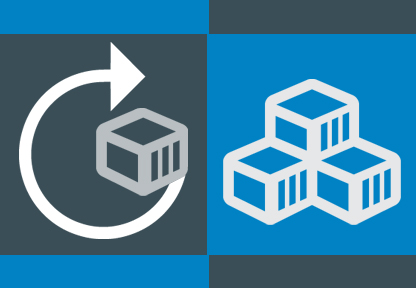You’ve heard about container technology; however, will it work with your infrastructure? Find out the answer today. For most situations, you’ll be able to run all your applications and other systems through containers. In fact, you run Microsoft and Linux operating systems in containers. With any technology situation, the devil is in the details. To avoid unplanned downtime, your approach to container strategy needs to follow this two-part strategy.
Part 1: The Implementation Approach to Containerization
From experience, there are two broad ways to approach bringing new technology to your organization. First, you can view the technology as a separate project that IT leads. Second, you can integrate the project into a broader technology transformation project. Each strategic option has its pros and cons in delivering the productivity benefits of containers.
The Project Approach to Container Implementation
The project approach is excellent for smaller organizations and those with minimal legacy systems to manage.
Pros
- Speed: This project approach will bring container technology to your staff quickly. It could be done in a matter of weeks if you implement at a small scale.
- Minimal consultation: For those who don’t enjoy meetings and stakeholder consultation, this streamlined project approach will involve little or no interaction with non IT stakeholders.
- Well suited for pilot tests: If you’re proposing a pilot test for containers, the project approach is a good fit.
Cons
- Lower integration performance: Will the containers work smoothly with other parts of your IT infrastructure? You may not know with a project approach because you’re likely to do minimal testing.
- Potential productivity losses: With minimal consultation, you may not know the downstream impacts of using containers. As a result, you may have some system glitches at first.
- Higher risk of cybersecurity failures: By using a fast approach to container implementation, you may skip some or all of your normal cybersecurity processes. That means you may not know the risks you’re taking by using containers.
The Technology Transformation Approach yo Container Implementation
This strategy is an excellent approach for organizations that have significant legacy systems. By the way, “legacy systems” doesn’t just mean mainframes. If you’re using virtual machines or a significant number of outsourced IT providers, a transformation approach is probably the right choice for you.
Pros
- Reduce risk: By taking a broad view of your technology infrastructure, you reduce the risk of malfunctions, glitches, and security problems. Your legacy systems are less likely to have problems with this approach.
- Identify other technology improvement opportunities: When you embark on a technology transformation project, you’ll spot problems and other areas to improve. For example, you may find out that your cloud service providers can be scaled back.
- Achieve high level of support from stakeholders: A transformation strategy requires you to earn support from stakeholders across the organization. By winning that support, you’ll face minimal resistance to change.
Cons
- Requires robust leadership support: Leadership always matters, but it matters even more when you lead the transformation. If you have a program or project manager on the bench, leading transformation is a good way to put that person to work.
- Takes longer to complete vs. a project approach: Transformation isn’t easy. It would be surprising if you could achieve such a transformation in less than a year. Large companies often take several years to implement a strategy.
If you have the patience for it, adopt the transformation strategy.
Part 2: Cybersecurity Management
A cybersecurity failure is so expensive that it needs to be considered on its own. When you make a change to your technology environment, it has implications for all your existing cybersecurity solutions. For example, you may need to update your training program. Senior management may ask you to redesign your reporting systems.
In addition to firewalls and employee training, there’s another critical component to cybersecurity controls for containers: identity and access management. When this practice is weak, you’re more likely to have problems. For instance, a disgruntled employee could resign on a Friday and use his or her access credentials to harm the organization.
Elements of a successful cybersecurity program for container implementation include:
- Risk assessment: At the start of the project, evaluate the risk impact of using containers. Expect that some risks will be reduced while other risks (e.g., identity management) may increase.
- Policy and procedure review: The documents, forms, and guidance provided to employees need to be revised. Otherwise, employees may assume that cybersecurity controls don’t apply to containers.
- Resource review: Ask the tough question: do you need more resources to protect your containers from security threats? You may need resources for additional staff or for an identity management solution.
- Third-party testing: When a cybersecurity department becomes well established, it becomes difficult to find all the relevant threats, so you may want to consider engaging a third party to perform penetration testing and checks.
- Reporting and metrics: You should be reviewing your cybersecurity reports annually. Do they add value to senior management? If not, seek to simplify your reports. For example, if you eliminate legacy technology such as virtual machines, you may not need to provide security metrics on those any longer.
While we’ve discussed them as distinct processes, your overall implementation and cybersecurity projects need to be integrated.
Introducing Identity Anywhere – Your Docker-compatible Identity Management Solution
When you choose an identity management solution, compatibility is important. Who wants to waste time on expensive customization? That’s why Identity Anywhere is built to be compatible with Docker Container. What if you make a mistake in setting up identity management? With rollback, you can simply revert to the last version. That means no time wasted retyping data.
If you’ve already started your Docker implementation, make sure to avoid these eight implementation mistakes. The worst mistake to make is the first one: no business case. Implementing a new technology without management support will just make your life more difficult.




